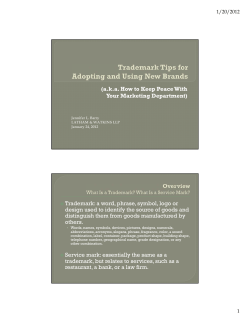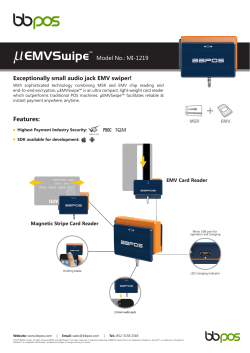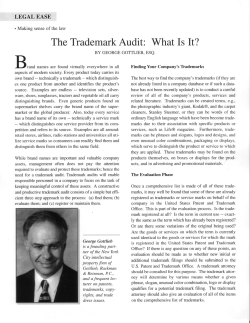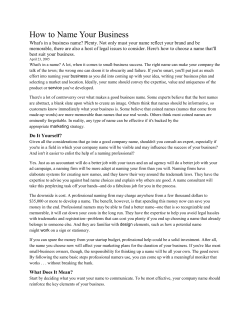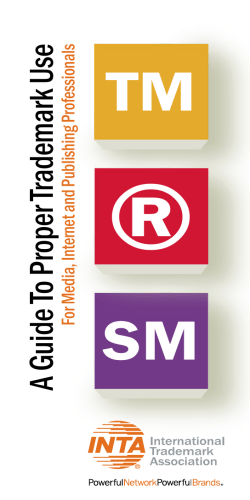
DOMAIN NAME CEASE AND DESIST LETTER & GUIDE Included:
DOMAIN NAME CEASE AND DESIST LETTER & GUIDE Included: Overview Dos and Don’ts Checklist Domain Name Cease and Desist Letter Instructions Sample Domain Name Cease and Desist Letter © LEGALZOOM.COM, INC. 2008 1. Overview You’ve started a business, established a brand name, and built a strong reputation for quality and service. Unfortunately, your competitors may not be willing to let you walk away with the solid market position you’ve earned. In some cases, those companies may want to cash in on the hard work you’ve put into growing your business, selecting a domain name identical to your trademark, or similar enough to cause confusion among your customers and the public at large. Your trademark is your marketplace signature, an indicator that your company produced the items for sale and a promise that those items will meet the quality standards you’ve worked to establish. If another company or individual attempts to register your trademark as a domain name for their own use (sometimes called “cybersquatting”), it’s akin to a forgery, a use of your ‘signature’ to obtain customers or signal your approval of its products. This forgery will not only cause an immediate decrease in your sales by siphoning purchasers to a different company’s website, but will cause a long-run decrease as well, as the power of your brand will be diluted by association with lesser quality goods. By law, you must challenge any infringement on your trademark to hold onto the protections you’ve earned: in other words, to keep your trademark you have to defend it. The letter included in this packet is constructed to help you get what is rightfully yours. Of course, you know your industry and competitors better than anyone else: this may be an intentional appropriation or an honest mistake. In any event, you may want to alter the sample letter to best suit your business needs. 2. Dos & Don’ts Checklist Before sending out letters full of demands, consider very carefully what constitutes infringement and how you will handle the situation. This is of particular concern online. Recipients of threatening letters may forward them on, and your company may face an immediate flood of angry e-mails, news inquiries, or boycotts. Ask yourself what use is being made of the trademark. Is it a competitor? A fan of your company? A parody? Not every use is to your detriment and you should think about how a continuation of another party’s use will affect you and your business. The language in the sample letter should be adapted to fit with the specific instance of infringement you’ve experienced. If a small company is just starting out and has not invested time or money into its domain name, consider tempering the language of the letter. If a direct competitor is clearly and aggressively infringing on your mark, consider making the language more forceful. In many cases, a simple phone call might be a good starting point. Examine the mark you think is infringing on your trademark. It must be both confusingly similar to yours and used in a related product area. You may own “John’s Body Works” for your car company, but you would have a hard time proving that a beauty salon with the same name would confuse your customers. When you register your domain name, register all possible variations to prevent later conflict or litigation. The acquirer of a domain name should search for existing uses of that name. As the number of top-level domain extensions (e.g., .com, .net, and .org) increases, the possibilities for DOMAIN NAME CEASE AND DESIST LETTER © LEGALZOOM.COM, INC. 2008 1 overlap and confusion increase as well. Search thoroughly around the internet for names that could lead to customer misunderstanding or mistake, including common misspellings or slightly different domain names (including plural forms of words). Generally, information about ownership of an infringing name can be found using a “whois” server. One form of cybersquatting is typosquatting, in which common misspellings or slight alterations in a domain name are registered in competition with a company’s site. Note that it is not the mere registration that is problematic: it is the use of this name in competition with the trademark owner and its products. If the other site is not competing with your company, you may not be able to complain of infringement. Make sure you are the actual trademark owner before you start this process. Do you have priority rights in this mark? Did you start using it in connection with your business before the other company did? Confirm that you are not the infringing party before leveling any accusations. Even if your trademark is registered with your state or with the U.S. Patent & Trademark Office (USPTO), you do not have rights in that mark until you have actually used it in your business. You can send out a cease and desist letter even if you haven’t registered your trademark with the USPTO. However, you may be able to defend your unregistered mark only within certain geographic parameters. If your trademark is not registered, send a sample of your mark with the cease and desist letter. If your trademark is registered, attach a copy of your USPTO registration. All of your correspondence with infringing companies and individuals should be kept in an organized and accessible file. If the infringement continues, this will show your vigilant defense of your trademark and will provide evidence that the other company was intentionally infringing after receiving notice. Protecting your trademark isn’t limited to guarding against infringement. You must continue to use that trademark in your business. The law will not protect your rights in an unused trademark. Be prepared to take additional steps if the company doesn’t respond and/or continues to use the infringing domain name. Failure to act in a reasonable period is called “acquiescence,” and could lead to limitation or termination of your trademark rights. DOMAIN NAME CEASE AND DESIST LETTER © LEGALZOOM.COM, INC. 2008 2 3. Domain Name Cease and Desist Letter Instructions The following instructions will help you understand the terms of your sample cease and desist letter. The numbers below correspond to numbers in the letter. Please review the entire document before starting your step-by-step process. 1. Insert the name of the person at the infringing company to whom you think this letter should be addressed. If you do not know the actual name of this person, insert a title (for example, President, Chief Executive Officer, or General Counsel). 2. Use this language if your company has not registered your trademark, and attach a sample of your trademark to the letter. Delete this clause if you have registered your trademark. 3. Use this language if your company has registered its trademark, and attach a copy of the USPTO registration to the letter. Insert your trademark registration number into the blank space provided. Delete this clause if you have not registered your trademark. 4. If your company owns a domain name that it is currently using in commerce, enter that name in the blank provided. If you do not own such a name, delete this bracketed sentence. 5. You can increase or decrease the time frame within which the infringing party must respond to you. We have entered a default number of 14 days, since that allows enough time for a response while providing evidence that your company takes this matter seriously. 6. Since this letter requests a written response within a certain number of days, you must provide an address (either physical or e-mail) to which this response can be sent. A company that uses the tools provided in this package can protect the brand it has worked so hard to build. If additional legal action needs to be taken, you can demonstrate your vigilant defense of the trademark and provide the documentation needed to protect your business from future dilution and infringement. DISCLAIMER LegalZoom is not a law firm. The information contained in the packet is general legal information and should not be construed as legal advice to be applied to any specific factual situation. The use of the materials in this packet does not create or constitute an attorney-client relationship between the user of this form and LegalZoom, its employees or any other person associated with LegalZoom. Because the law differs in each legal jurisdiction and may be interpreted or applied differently depending on your location or situation, you should not rely upon the materials provided in this packet without first consulting an attorney with respect to your specific situation. The materials in this packet are provided "As-Is," without warranty or condition of any kind whatsoever. LegalZoom does not warrant the materials' quality, accuracy, timeliness, completeness, merchantability or fitness for use or purpose. To the maximum extent provided by law, LegalZoom, it agents and officers shall not be liable for any damages whatsoever (including compensatory, special, direct, incidental, indirect, consequential, punitive or any other damages) arising out of the use or the inability to use the materials provided in this packet. DOMAIN NAME CEASE AND DESIST LETTER © LEGALZOOM.COM, INC. 2008 3 Form Sample DOMAIN NAME CEASE AND DESIST LETTER © LEGALZOOM.COM, INC. 2008 4
© Copyright 2026


